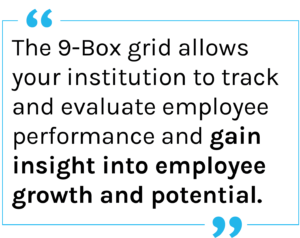Career pathing can make a difference for your institution in attracting talent.
 Higher education has not been immune from the great resignation, and as academia faces increasing competition for talent from other sectors, including the tech sector, institutions have to work harder to hire and retain employees. Talent engagement and growth are critical to employee retention, and the benefits of centralized and visible career pathing opportunities should not be underestimated. Tools like the 9-box grid can make a huge difference in the employee review process.
Higher education has not been immune from the great resignation, and as academia faces increasing competition for talent from other sectors, including the tech sector, institutions have to work harder to hire and retain employees. Talent engagement and growth are critical to employee retention, and the benefits of centralized and visible career pathing opportunities should not be underestimated. Tools like the 9-box grid can make a huge difference in the employee review process.
Read on to learn more about the importance of career paths, employee development, and internal succession planning, and the tools that can help you keep employees engaged.
The Importance of Employee Development
The Society for Human Resource Management (SHRM) reports that “when employees were asked to indicate the top factors that would cause them to look for new employment over the next 12 months, lack of career progress topped the list…. the importance of promotion and job advancement… is underestimated by executives.” For higher education institutions to be competitive workplaces, especially for the younger generations, there must be a focus on nurturing and engaging current employees.
According to GlassDoor, employees are three times more likely to leave their workplace when taking a new job than to move to a new role within the workplace. When an employer has defined avenues for career growth and clear review processes in place, employees often feel more engaged and are more likely to seek out new opportunities internally. By keeping talent moving within your institution, you’re reducing hiring costs as well as helping to build an internal talent pipeline that makes succession planning easier and offers opportunities to diversify your leadership team.
within the workplace. When an employer has defined avenues for career growth and clear review processes in place, employees often feel more engaged and are more likely to seek out new opportunities internally. By keeping talent moving within your institution, you’re reducing hiring costs as well as helping to build an internal talent pipeline that makes succession planning easier and offers opportunities to diversify your leadership team.
Clear career paths don’t just help you retain current talent, but can also help your institution remain competitive when recruiting new talent. A thorough career-pathing program can help hiring teams craft better job descriptions and can help your institution attract high-achieving talent. SHRM notes that “employers can easily differentiate themselves from competitors by investing in their employees’ career development.” Many organizations don’t devote the necessary time and resources to employee development, meaning that even small investments in growth and engagement can make your institution stand out from the crowd.
Career Pathing Tools
There are many different methods and tools available to help human resources teams with career pathing, talent management, and succession planning. Some organizations use AI to match employee skills with organizational needs, while others use talent pools to ensure they have qualified people on hand to fill positions when needed. Skills gap analyses can be a useful tool to offer insight into what skills employees need to succeed in their current and future roles, and can help organizations allocate resources for development and training. Many organizations utilize personality and behavioral assessments to predict which employees will make a good fit for managerial and gain an understanding of leadership potential on their staff. Career maps, created by managers and employees in partnership, take into account a knowledge and skills assessment as well as the employees interests and experience.
The 9-Box grid is another useful tool for your institution to track and evaluate employee performance and gain insight into employee growth and potential. 9-Box grids allow managers to map employee performance and potential to understand, for example, which employees need support or guidance to succeed or which might grow into institutional leaders with the right training. With PeopleAdmin’s soon-to-be-released 9-Box dashboard feature, your HR team will have a centralized, digital tool that gives them a better understanding of the valuable talent in your organization and provides a jumping off point for a career pathing structure that will take employee engagement to the next level. Keep an eye out the release of this latest feature on the HigherEd Platform!
is another useful tool for your institution to track and evaluate employee performance and gain insight into employee growth and potential. 9-Box grids allow managers to map employee performance and potential to understand, for example, which employees need support or guidance to succeed or which might grow into institutional leaders with the right training. With PeopleAdmin’s soon-to-be-released 9-Box dashboard feature, your HR team will have a centralized, digital tool that gives them a better understanding of the valuable talent in your organization and provides a jumping off point for a career pathing structure that will take employee engagement to the next level. Keep an eye out the release of this latest feature on the HigherEd Platform!
Steps to Take toward Career Pathing
To develop a career pathing program for your institution, you must first define the outcomes that you’re looking for. Examine your organizational chart, take a look at the career paths of current institutional leaders, examine job descriptions, and define key skills that could be enhanced with training or development. To encourage growth, be sure to advertise internal job postings within your institution and offer dynamic learning and development opportunities. HR leaders should also encourage frequent performance reviews and career conversations so employees know where they stand and employers can see where employees want to go next. Career pathing has many benefits for employees and organizations—if you don’t have a career pathing model in place, now is the time to start!